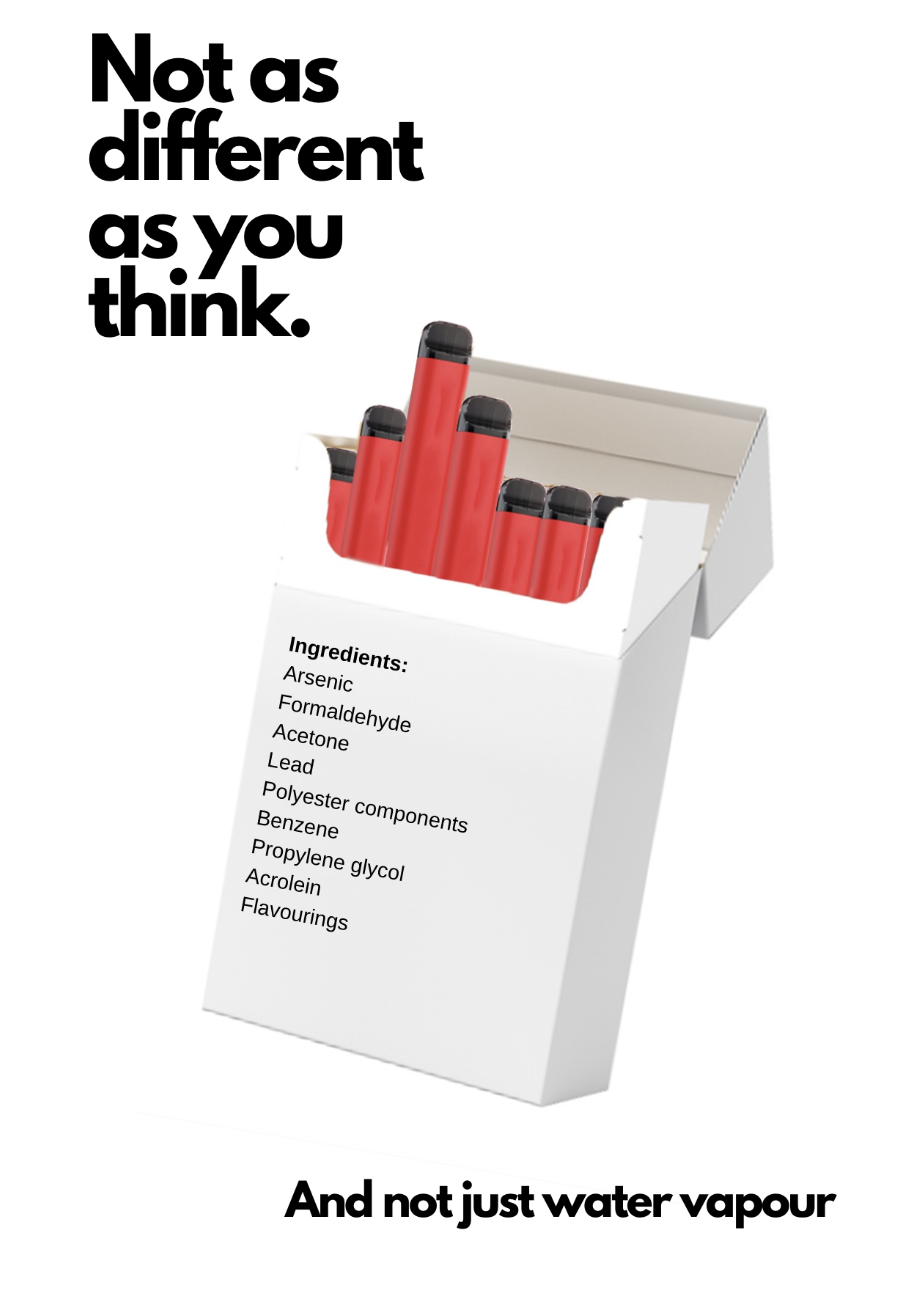The fact that smoking is harmful is not a novel idea. Smoking causes 7 million death per year and smokers live on average 10 years less than non-smokers (Striley & Nutley, 2020).
Vaping was introduced in the early 2000s as a smoking cessation product. These days you are far more likely to see a person vaping than smoking, which might lead you to conclude this shows that vaping is a successful harm reduction tool. There is the perception among some that vaping is less harmful than tobacco cigarettes, but recent reports show evidence to the contrary (Levy et al., 2019).
What’s in an e-cigarette?
Some of the chemicals found in e-cigarettes include formaldehyde, arsenic, nickel, tin, lead, cadmium, propylene glycol (a solvent used in fog or smoke machines), polyester compounds, di-ethylene glycol (commonly found in vehicle coolant), volatile organic compounds such as benzene (found in paint and heavy duty cleaning products), acrolein (a herbicide) other carcinogenic additives, and flavourings that may be safe to consume but unsafe to inhale. You can learn more about the chemicals in vapes on the Vape Truths website.

How is this harmful?
The risks from vaping include inflammation and oxidative stress from aerosol inhalation as well as DNA damage, arterial stiffness, reduced pulmonary function and cardiovascular damage (Chand et al., 2020; Chatterjee, et al., 2019). There is also evidence that second-hand inhalation of vapes can cause respiratory symptoms in healthy non-smokers (Tzortzi et al., 2019). Some studies have shown that after recovering from a vape-related lung injury, patients were more susceptible to further infections (Chand et al., 2020).
Adolescents and young adults who initiate smoking behaviours are increasingly choosing vapes over cigarettes, indicating that vapes are not just being used as a smoking cessation device (Tattan-Birch et al., 2020). Studies have also shown that people who start out using vapes are three times more likely to take up smoking cigarettes in the future, learn more about the correlation on the Positive Choices website.
Because vapes are so new to the market, there is insufficient legislation around packaging, labelling and marketing, meaning that young people are at risk of initiating vaping behaviours without being adequately informed of the risks.
There is more to vape than just water vapour. If you or someone you know at Curtin is looking for support to quit smoking or vaping, you can contact Curtin Psychological and Counselling Services for cessation support.
For additional support, there are a number of great resources available online:
- Australian Government Department of Health website
- Quit website
- Cancer Council website
- Health Direct website
References:
Chatterjee, S., Tao, J.Q., Johncola, A., Guo, W., Caporale, A., Langham, M.C. & Wehrli, F.W. (2019). Acute exposure to e-cigarettes causes inflammation and pulmonary endothelial oxidative stress in nonsmoking, healthy young subjects. Am J Physiol Lung Cell Mol Physiol, 317(2). 155-L166. doi: 10.1152/ajplung.00110.2019.
Chand, H.S., Muthumalage, T., Maziak, W. & Rahman, I. (2020). Pulmonary Toxicity and the Pathophysiology of Electronic Cigarette, or Vaping Product, Use Associated Lung Injury. Frontiers in Pharmacology, 14. https://doi.org/10.3389/fphar.2019.01619
Levy, D., Warner, K.E., Cummings, K.M., Hammond, D, Kuo, C., Fong, G.T, Thrasher, J.F., Goniewicz, M.L. & Borland R. (2019). Examining the relationship of vaping to smoking initiation among US youth and young adults: A reality check. Tobacco Control, 28, 629-635.
Striley, C. & Nutley, S. (2020). World vaping update. Current Opinion in Psychiatry, 33 (4), 360-368. doi: 10.1097/YCO.0000000000000617.
Tattan-Birch, H., Brown, J., Shahab, L. & Jackson, S.E. (2020). Association of the US outbreak of vaping-associated lung injury with perceived harm of ecigarettes compared with cigarettes. JAMA Netw Open, 3(6), 206981. doi:10.1001/jamanetworkopen.2020.6981
Tzortzi, A.S., Teloniatis, S.I., Matiampa, G., Bakelas, G., Tzavara, C., Vyzikidou, V.K., Vardavas, C.I., Behrakis, P.K., & Fernández, E. (2019). Passive exposure of non-smokers to e-cigarette aerosols: Sensory irritation, timing and association with volatile organic compounds. Environmental research, 182, 108963. DOI:10.1016/j.envres.2019.108963



